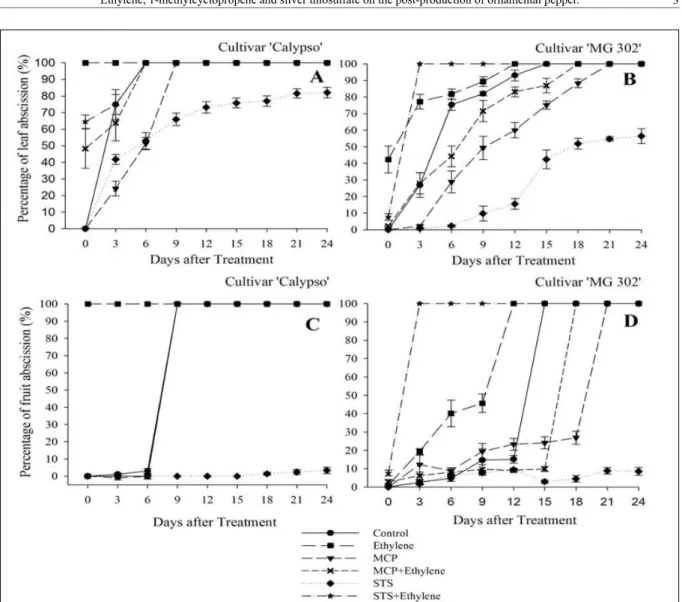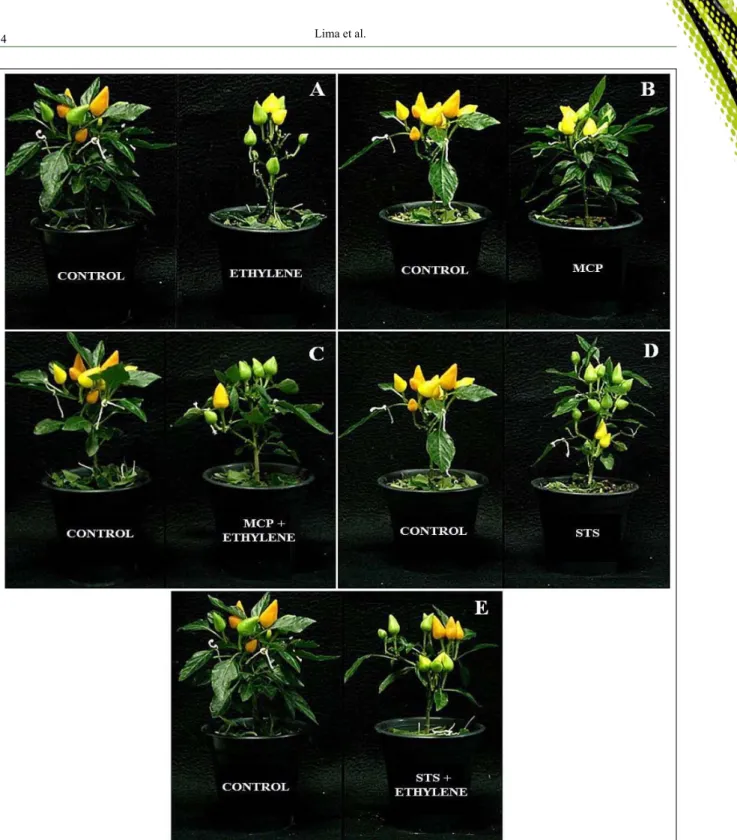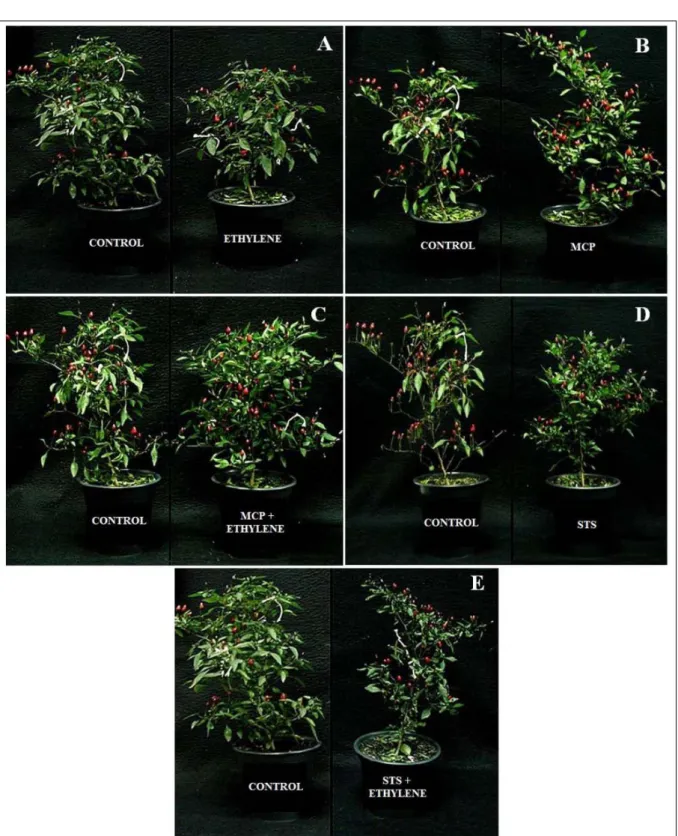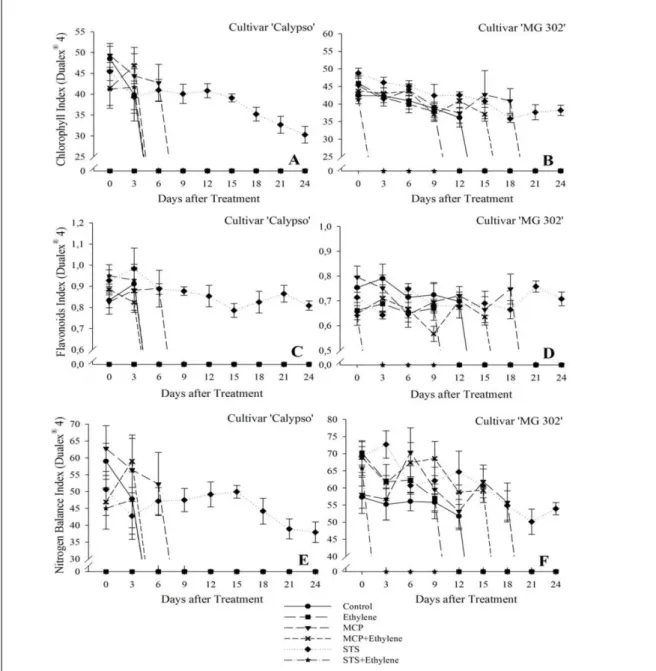Ethylene, 1-methylcyclopropene and silver thiosulfate
on the post-production of ornamental pepper
Etileno, 1-metilciclopropeno e tiossulfato de prata na pós-produção de pimenteiras ornamentais
Paula Cristina Carvalho Lima1 Wellington Souto Ribeiro3 Milena Maria Tomaz de Oliveira2 Lucas Cavalcante da Costa1 Fernando Luiz Finger3
ISSNe 1678-4596
INTRODUCTION
The species of the genus Capsicum presented large genetic variability and have being used for different purposes, mainly as condiment, but the marketing as potted ornamental plants has increased in the past decade (STOMMEL & BOSLAND, 2006). However, there are serious obstacles affecting the quality and shelf life of ornamental potted plants or at post-production phase, with special attention to adverse effects when exposed to ethylene (HOYER, 1996; SEGATTO et al., 2013).
A wide range of biotic and abiotic stresses may increase endogenous levels of ethylene, which may
induce senescence of leaves and flowers (MAYAK et al., 2004; SIDDIKEE et al., 2011). Ethylene may accumulate
to high concentrations in the atmosphere during growth in greenhouses, shipping and storage facilities due to lack of proper ventilation and scrubbing. FARANGUER et al. (2002) estimated that the deleterious effects of ethylene
are responsible for 30% of losses in the floriculture
industry. One way to control the ethylene effects in plants is the use of ethylene action inhibitors, so forth, blocking the effects of ethylene during shipping, storage and marketing of fresh products (PORAT et al., 1995).
According to FINGER et al. (2015), in order to improve post-production life, it is necessary to block the ethylene receptors before exposing the plant to ethylene during shipping, storage and retail stores or when plants are submitted to any stress that might induce ethylene production. There are several problems 1Departamento de Fisiologia Vegetal, Universidade Federal de Viçosa (UFV), Viçosa, MG, Brasil.
2Departamento de Fitotecnia, Universidade Federal do Ceará (UFC), Fortaleza, CE, Brasil.
3Departamento de Fitotecnia, Universidade Federal de Viçosa (UFV), Avenida Peter Henry Rolfs, s/n, Campus Universitário, 36570-900,
Viçosa, MG, Brasil. E-mail: finger@ufv.br. Corresponding author.
ABSTRACT:Species from Capsicum genus are used for different purposes and in more recent years as ornamental potted plant. Despite the
increased commercial importance, there are only a few studies on the environmental factors affecting the post-production shelf life of these ornamental plants. The presence of ethylene induces various responses on potted peppers, reducing the shelf life of sensitive cultivars. This study aimed to evaluate the effects of ethylene and the inhibitors of ethylene action, 1-methylcyclopropene (1-MCP) and silver thiosulfate (STS) on the shelf life of potted ‘Calypso’ and ‘MG 302’ peppers. Cultivar ‘MG 302’ showed intermediate sensitivity to ethylene action, while the cultivar ‘Calypso’ showed complete abscission of leaves when exposed to ethylene. In both cultivars, treatment with STS + Ethylene presented symptoms of phytotoxicity in plants, while treatment with 1-MCP + Ethylene was effective in delaying senescence and abscission for the cultivar ‘MG 302’, while cultivar ‘Calypso’ showed abscission similar to control plants. Plants treated with STS showed the longest durability when compared to the other treatments, about six days for ‘Calypso’ and 18 days for ‘MG 302’. Nevertheless, plants treated with 1-MCP also exhibited good shelf life, about six days for ‘Calypso’ and nine days for the ‘MG 302’. Although the treatment with STS was more efficient on the plants shelf life, did not completely block the action of ethylene and exhibited some phytotoxicity, while the treatment with 1-MCP had good efficiency without inducing any toxicity.
Key words:ethylene action inhibitors, leaf abscission, Capsicum annuum.
RESUMO: Espécies do gênero Capsicum estão sendo usados para diversas finalidades e nos últimos anos como planta ornamental de vaso. Apesar
da crescente importância comercial, há poucos estudos sobre os fatores ambientais que afetam a sua vida útil de pós-produção destas plantas ornamentais. A presença de etileno induz várias respostas em pimenteiras em vasos, reduzindo a vida útil de prateleira de cultivares sensíveis. Este estudo teve como objetivo avaliar os efeitos do etileno e inibidores da ação do etileno, 1-metilciclopropeno (1-MCP) e tiossulfato de prata (STS) sobre a vida útil de vaso de pimenteiras das cultivares ‘Calypso’ e ‘MG 302’. A cultivar ‘MG 302’ apresentou sensibilidade intermediária a ação do etileno, enquanto a cultivar ‘Calypso’ apresentou abscisão completa das folhas quando exposta ao etileno. Em ambas as cultivares, o tratamento STS + Etileno mostrou sintomas de fitotoxicidade nas plantas. O tratamento com 1-MCP + Etileno foi eficaz em retardar a senescência e abscisão apenas para a cultivar ‘MG 302’, enquanto a cultivar ‘Calypso’ mostrou abscisão foliar semelhante as plantas controle. Plantas tratadas com STS mostraram maior durabilidade quando comparadas aos outros tratamentos, cerca de seis dias para ‘Calypso’ e dezoito dias para ‘MG 302’. No entanto, as plantas tratadas com 1-MCP também exibiram boa vida útil de prateleira, cerca de seis dias para ‘Calypso’ e nove dias para a ‘MG 302’. Embora o tratamento com STS tenha sido mais eficiente na vida de prateleira das plantas, não bloqueou completamente a ação do etileno e apresentaram algum fitotoxicidade, enquanto o tratamento com 1-MCP teve boa eficiência sem induzir qualquer toxicidade.
Palavras-chave: inibidores da ação do etileno, abscisão, Capsicum annuum.
2 Lima et al.
encountered at post-production stage that affect the quality and vase life of ornamental plants, but in general the exposure to ethylene is one of the most important.
Ion silver is the most potent inhibitor of ethylene action by competing for the binding sites of
ethylene receptors (KUMAR et al., 2009). Silver is
more effective when applied as silver thiosulfate (STS) - [Ag(S2O3)2-3], because has faster mobility and less
phytotoxic than silver nitrate (AgNO3) to the tissues (VAN ALTVORST & BOVY, 1995). 1-Methylcyclopropene (1-MCP) is another effective substance that blocks the action of ethylene in fruits, vegetables and ornamental plants in general. However, of effectiveness degree of 1-MCP in blocking the ethylene action varies among the plant species, stage of development, plant maturity, concentration, length of treatment and temperature
during treatment (BLANKENSHIP & DOLE, 2003).
The goal of this study was to evaluate the effects of ethylene, 1-MCP and STS on post-production quality of
Capsicum annum ornamental cultivars grown in pots.
MATERIALS AND METHODS
Seeds from the cultivars ‘Calypso’ and ‘MG 302’ (Capsicum annuum) were sown in flats with
single cells and transplanted to 760mL plastic pots when
the plantlets had four to five true leaves. Pots containing one plantlet each were filled with commercial substrate
Tropistrato HT® composition: pine bark, vermiculite,
superphosphate, potassium nitrate (Vida Verde, LOT 14072106) and grown in a greenhouse for four months until ready for commercial sale. Pots were fertilized
at every 20 days with 10g of NPK 10-10-10 and
monthly with a diluted solution containing 150g L-1
of commercial Ouro Verde Fertilizer® 15-15-20 NPK
+ Ca, S, Mg, Zn, B, Fe, and Mn (Bunge, Sao Paulo, Brazil). When commercial stage for sale was reached, according to RIBEIRO et al. (2015), 50% of the plants in a population showed at least 30% of fully ripe fruits (typical shape for each material, color demanded by the market, and no wilting). Afterwards, the pots were transferred to a room at 25+1oC, illuminated for 12 hours period with white fluorescent light (OSRAM,
L40W/10S, USA) with intensity of 8-10µmol s-1 m-2
during the experimental period (SEGATTO et al., 2013). Pots were then placed in a 90L sealed chambers for 1-MCP and ethylene treatment, according to the methodology of SEGATTO et al. (2013). Plants of all
treatments were kept at 25±1°C under white fluorescent
light with intensity of 8-10µmol s-1 m-2, 60-65% relative
humidity and watered when needed (FINGER et al., 2015).
Plants were treated with 10μL L-1 ethylene for 48 hours; fumigation of 1μL L-1 1-MCP for 6 hours;
treated with 1μL L-1 1-MCP for 6 hours followed by
10μL L-1 ethylene for 48 hours; plants were sprayed
until run off with 5mL of 2mmol L-1 STS; sprayed until
run off with 5mL of 2mmol L-1 STS per plant followed by treatment with 10μL L-1 ethylene for 48 hours. The
control plants were kept on the laboratory bench. Leaf and fruit abscissions were determined at every three days by counting the total leaves during the whole period of shelf life, expressed in percentage compared to the initial leaf counting. Longevity and yellowing of the leaves were determined at every three days up to 18 days. The end of longevity occurred when the plants did not have commercial value, 50% of leaf and fruit abscission and/or 50% yellowing of leaves (FINGER et al. 2015).
Degree of green color and flavonoids of
the leaves was evaluated in three leaves in each plant: base, center and top, the average of determinations were considered. The chlorophyll content of leaves was determined by the chlorophyll index – Chl, the
flavonoids index – Flav and nitrogen balance index
– NBI were also determined, giving the reason CHL/
FLAV, nitrogen deficiency and protein rate marker.
All these variables were evaluated at every three days with the help of a leaf-clip portable meter Dualex® 4, design to measure chlorophyll, epidermal flavonoids
and nitrogen balance index (FORCE-A, Université Paris Sud, 91893 ORSAY CEDEX, France). This instrument is used for non-destructive assessment of plant status, especially in regards to the simultaneous assessment of Chl and Flav on the same leaf spot, and was equipped with 6mm diameter sensor in the measuring area and silicon photodiode detector (CEROVIC et al., 2012).
Pots were arranged in complete randomized
block design with five replicates of one pot each. The
average of the parameters analyzed were submitted to the standard error of the average (n=5) and SigmaPlot software was used for data analysis and graph design.
RESULTS AND DISCUSSION
The treatment with 10µL L-1 ethylene for 48
hours induced 100% abscission of leaves on cultivar ‘Calypso’ (Figure 1A and Figure 2A), while ‘MG 302’ showed intermediate response to ethylene with 42% of leaf abscission after treatment (Figure 1B and Figure
3A). Confirming the high sensitivity of ‘Calypso’ leaves to ethylene previously identified by SEGATTO et al.
(2013) and FINGER et al. (2015). The sensitivity of ornamental plants to ethylene was roughly established at family level, but marked differences exist among the
Sensitivity of ornamental plants to ethylene is roughly established at family level, but marked differences exist among species and cultivars
(SEREK et al., 2006). Previously SEGATTO et
al. (2013) reported that genotypes of ornamental pepper BGH 1039, BGH 7073, ‘Calypso’ and ‘MG 302’ had different levels of sensitivity to ethylene, in which the cultivar ‘Calypso’ and access BGH
1039 were classified as highly sensitive. The authors
reported that ethylene unleashed a severe and rapid abscission of leaves for ‘Calypso’, but the cultivar ‘MG 302’ showed intermediate response to treatment, with abscission ranging from 15 to 38% after being exposed to 10µL L-1 ethylene for 48 hours.
Plants treated with 1-MCP exhibited shelf life of about 6 days for ‘Calypso’ and 9 days for ‘MG 302’ (Figure 1 A, Figure 1 B, Figure 2 B and Figure 3 B).
FINGER et al. (2015) concluded that 1-MCP treatment was effective in partially preventing the sudden fall of leaves in presence of exogenous ethylene in ornamental pepper ‘Calypso’. Treatment of plants with 1-MCP has been effective in blocking the negative effects of
ethylene different flowers, including some varieties of
roses, geranium, Phalaenopsis, dianthus and gentian (SHIMIZU-YUMOTO & ICHIMURA, 2012).
Treatment with 1-MCP followed by ethylene showed abscission similar to the control plants in cultivar ‘Calypso’; however showed some
efficacy for the cultivar ‘MG 302’, showing a
durability of 6 days (Figure 1A, Figure 1B, Figure 2C and Figure 3C). According to PHEBE & ONG (2010), the effectiveness of 1-MCP in extending the shelf life varies with species and variety, ripening stages, and exposure temperature, concentration and duration. In
4 Lima et al.
this study the 1-MCP dose partially efficient, because
did not blocked all ethylene receptors and when ethylene was applied, still triggered leaf abscission. Similar post-production behavior was also obtained when Regal Pelargonium genotypes were pretreated
with 1-MCP before they had been exposed to ethylene
(KIM et al., 2007).
Plants treated with STS showed improved durability when compared with other treatments, for about 6 days for ‘Calypso’ and 18 days for ‘MG 302’
(Figure 1A, Figure 1B, Figure 2D and Figure 3D). According MOURA et al. (2010) the performance of the STS depends on the cultivar, stage of development and concentration used. The application of 0.5, 1.0,
1.5 and 2.0mM STS in potted ‘Rage’ chrysanthemum increased in 50% the display time compared to non-treated plants and no effect in the same concentration were observed in ‘Summer Time’ and ‘Davis’
6 Lima et al.
(BARBOSA et al., 2005). In both cultivars, treatment with STS + Ethylene caused symptoms of phytotoxicity on the plants, showing senescence and abscission on ‘Calypso’ (Figure 1A and Figure 2E) and senescence and wilting on ‘MG 302’ (Figure 1B and Figure 3E).
Thus, pretreating these peppers with 1-MCP or STS complements the resistance to ethylene, but did not reduce the sensitivity to its action, once the treatment is completed. It has been suggested that only by incorporating genes of resistance in new cultivars it will be possible to improve the longevity of ethylene-sensitive ornamental plants (FINGER et al. 2015).
In general, fruit abscission percentage remained low during shelf life observations of all treatments (Figure 1C and Figure 1D), this research
confirmed the low fruit abscission on ‘Calypso’ and
higher rates of fruit abscission on ‘MG 302’ previously
identified by SEGATTO et al. (2013). Ethylene
effectiveness on pepper fruit abscission depends on length to exposure, concentration, temperature, stage of development and sensitivity of species or variety
(SEREK et al., 2006; WATKINS, 2006).
The figure 4 shows the chlorophyll index (Chl), flavonoids index (Flav) and nitrogen balance
Figure 4 - Chorophyll Index – Dualex® 4 (A, B), Flavonoids Index – Dualex® 4 (C, D) and Nitrogen Balance Index – Dualex® 4 (E,
index (NBI) in plants of cultivars ‘Calypso’ and ‘MG 302’. Except for the treated pots, which had loss of the leaves, a persistent decline of this parameters took place during post-production period, for the ‘Calypso’ treated with STS by the end of the evaluations there was a decrease of 33.4% (45.43 to 30.27) for Chl; 12.9% (0.92 to 0.81) for Flav and 25.0% (50.61 to 37.94) for NBI, much lower compared to the other treatments (Figure 4A, Figure 4C and Figure 4E).
And also for the ‘MG 302’ treated with STS and 1-MCP, showed a decrease of 21.7% (48.78 to 38.20) and 4.99% (45.22 to 40.85) for Chl; 0.9% (0.71 to 0.70) and 5.0% (0.79 to 0.74) for Flav; 22.0% (69.18 to 53.94) and 2.2% (58.10 to 55.77) for NBI, respectively (Figure 4B, Figure 4D and Figure 4F). In plants treated with 1-MCP were delayed yellowing of leaves, similar to data of FINGER et al. (2015). MARINO et al. (2003) observed that during vase life both species of Asparagus
showed progressive senescence characterized by yellowing and falling of cladodes.
In order to improve post production life of ornamental peppers, it is necessary to block the ethylene receptors before exposing the plant to ethylene during shipping, storage and retail sales or when plants are submitted to any stress that induces ethylene production (FINGER et al., 2015). Ethylene acts by converting chlorophyll a and b in chlorophyllide and phytol, resulting in loss of green color usually at concentration varying from 1 to
10μL L-1 (FERRANTE & FRANCINI, 2004).
CONCLUSION
The action of ethylene inhibitors, 1-MCP or STS followed by ethylene do not completely block the ethylene action, but STS is more effective. STS cause some phytoxicity, while the
treatment with 1-MCP had good efficiency without
inducing any toxicity.
ACKNOWLEDGMENT
The research was supported in part by a grant from Fundação de Amparo á Pesquisa do Estado de Minas Gerais (FAPEMIG). Scholarships were provided by Conselho Nacional de Desenvolvimento Científico e Tecnológico (CNPq).
REFERENCES
BARBOSA, J.G. et al. Vida de prateleira de minicrisântemos em vaso tratados com tiossulfato de prata. Bragantia, v.64, n.4, p.673-678, 2005. Available from: < http://dx.doi.org/10.1590/S0006-87052005000400017> Accessed: sept. 29, 2015. doi: 10.1590/ S0006-87052005000400017.
BLANKENSHIP, S.M.; DOLE, J.M. 1-methylcyclopropene: a review. Postharvest Biology and Technology, v.28, n.1, p.1-25, 2003. Available from: <http://www.sciencedirect.com/science/ article/pii/S0925521402002466>. Accessed: sept. 29, 2015. doi: 10.1016/S0925-5214(02)00246-6.
CEROVIC, Z.G. et al. A new optical leaf-clip meter for simultaneous non-destructive assessment of leaf chlorophyll and epidermal flavonoids. Physiologia Plantarum, v.146, n.3, p.251-260, 2012. Available from: <http://www.ncbi.nlm.nih.gov/ pmc/articles/PMC3666089/#b12>. Accessed: jul. 28, 2016. doi: 10.1111/j.1399-3054.2012.01639.x.
FARANGUER, J. et al. Postharvest handling of australian
flowers-from australian native plants and related species, a
practical workbook. Australian: Rural Industries Research and
Development Corporation, 2002. N.02/021, 216p.
FERRANTE, A.; FRANCINI, A. Ethylene and leaf senescence. In: KHAN, A.N. Ethylene action in plants. Netherlands: Springer, 2006. p.51-67.
FINGER, L.F. et al. Inhibition of ethylene response by 1-methylcyclopropene in potted ornamental pepper. Ciência
Rural, v.45, n.6, p.964-969, 2015. Available from: <http://dx.doi.
org/10.1590/0103-8478cr20131386>. Accessed: sept. 25, 2015. doi: 10.1590/0103-8478cr20131386.
HOYER, L. Critical ethylene exposure for Capsicum annuum ‘Janne’ is dependent on an interaction between concentration, duration and developmental stage. Journal of Horticultural
Science, v.71, n.4, p.621-628, 1996.
KIM, H.J. et al. Ethylene resistance of Regal Pelargonium in complemented but not replaced by 1-MCP. Postharvest
Biology Technology, v.45, n.1, p.66-72, 2007. Available from:
< h t t p : / / w w w. s c i e n c e d i r e c t . c o m / s c i e n c e / a r t i c l e / p i i / S0925521407000257>. Accessed: sept. 28, 2015. doi: 10.1016/j. postharvbio.2006.08.021.
KUMAR, V. et al. AgNO3 - a potential regulator of ethylene
activity and plant growth modulator. Electronic Journal
Biotechnology, v.12, n.2, p.1-15, 2009. Available from: <http://
www.ejbiotechnology.info/index.php/ejbiotechnology/article/ viewFile/v12n2-1/704>. Accessed: sept. 29, 2015. doi: 10.2225/ vol12-issue2-fulltext-1.
MARINO, A. et al. Production and postharvest evaluations of ornamental Asparagus spp. Advances in Horticultural
Science, v.17, n.2, p.88-92, 2003. Available from: <https://
www.researchgate.net/publication/236942170_Production_ and_postharvest_evaluations_of_ornamental_Asparagus_spp>. Accessed: apr. 15, 2016.
MAYAK, S. et al. Plant growth-promoting bacteria confer resistance in tomato plants to salt stress. Plant Physiology and
Biochemistry, v.42, n.6, p.565-572, 2004. Available from: <http://
www.sciencedirect.com/science/article/pii/S0981942804000762>. Accessed: sept. 28, 2015. doi:10.1016/j.plaphy.2004.05.009.
MOURA, A. et al. Vida de vaso de inflorescências de Epidendrum ibaguense Kunth tratadas com inibidores de etileno. Revista
Brasileira de Horticultura Ornamental, v.16, n.2,
8 Lima et al.
PHEBE, D.; ONG, P.T. Extending ‘Kampuchea’ guava shelf-life at 27oC using 1-methylcyclopropene. International Food Research
Journal, v.17, p.63-69, 2010. Available from: <http://psasir.upm.
edu.my/16512/>. Accessed: sept. 27, 2016.
PORAT, R. et al. An increase in ethylene sensitivity following pollination is the initial event triggering an increase in ethylene production and enhanced senescence of Phalaenopsisorchid flowers. Physiologia
Plantarum, v.93, n.4, p.778-784, 1995. Available from: <http://
onlinelibrary.wiley.com/doi/10.1111/j.1399-3054.1995.tb05131.x/full>. Accessed: sept. 28, 2015. doi: 10.1111/j.1399-3054.1995.tb05131.x.
RIBEIRO, W.S. et al. Repeatability of agronomic and morphological characteristics in ornamental pepper. Horticultura
Brasileira,v.33, n.3, p.352-355, 2015. Available from: <http://
dx.doi.org/10.1590/S0102-053620150000300012>. Accessed: apr. 15, 2016. doi: 10.1590/S0102-053620150000300012.
SEGATTO, F.B. et al. Effects of ethylene on the post-production of potted ornamental peppers (Capsicum annuum L.). Acta
Horticulturae, v.1000, n.28, p.217-222, 2013. Available from:
<http://www.actahort.org/books/1000/1000_28.htm>. Accessed: sept. 28, 2015. doi: 10.17660/ActaHortic.2013.1000.28.
SEREK, M. et al. Controlling ethylene responses in flowers at receptor level. Biotechnology Advances, v.24, n.6, p.368-381, 2006. Available from: <http://www.sciencedirect.com/science/ article/pii/S0734975006000243>. Accessed: sept. 25, 2015. doi: 10.1016/j.biotechadv.2006.01.007.
SIDDIKEE, M.A. et al. Regulation of ethylene biosynthesis under salt stress in Red Pepper (Capsicum annuum L.) by 1-aminocyclopropane-1-carboxylic acid (ACC) deaminase producing halotolerant bacteria. Plant Growth Regululation, v.31, n.10, p.265-272, 2011. Available from: <http://link.springer. com/article/10.1007%2Fs00344-011-9236-6>. Accessed: sept. 28, 2015. doi: 10.1007/s00344-011-9236-6.
SHIMIZU-YUMOTO, H.; ICHIMURA, K. Effects of ethylene, pollination, and ethylene inhibitor treatments on flower senescence of gentians. Postharvest Biology and Technology, v.63, n.1, p.111-115, 2012. Available from: <http://www.sciencedirect.com/ science/article/pii/S0925521411002067>. Accessed: sept. 28, 2015. doi: 10.1016/j.postharvbio.2011.08.009.
STOMMEL, J.R.; BOSLAND, P.W. Ornamental pepper, Capsicum annuum. In: ANDERSON, N. Flower breeding and
genetics: issues, challenges and opportunities for the 21st Century.
Netherlands: Springer, 2006. p.561-599.
VAN ALTVORST, A.C.; BOVY, A.G. The role ethylene in the senescence of carnation flowers, a review. Plant Growth
Regulation, v.6, p.43-53, 1995.



